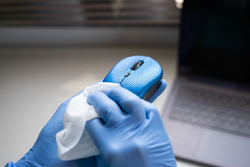Employer Solutions / HRMS Newsletter – June 2020
Keeping You Up-To-Date With Information About Employer Solutions / HRMS
Five Steps to Reduce the Spread of COVID-19 in the Workplace
 The impact of the COVID-19 pandemic is being felt by every company in every industry in the world. Business leaders have struggled to cope with the impacts of the crisis on their employees, customers, and the bottom line. Today, governments are beginning to relax restrictions and provide guidance on reopening businesses. As employees and customers begin to come back it is critical that business leaders do everything they can to maintain a safe environment for employees and customers. Here are 5 Steps to Reduce the Spread of COVID-19 in the Workplace.
The impact of the COVID-19 pandemic is being felt by every company in every industry in the world. Business leaders have struggled to cope with the impacts of the crisis on their employees, customers, and the bottom line. Today, governments are beginning to relax restrictions and provide guidance on reopening businesses. As employees and customers begin to come back it is critical that business leaders do everything they can to maintain a safe environment for employees and customers. Here are 5 Steps to Reduce the Spread of COVID-19 in the Workplace.
Step 1 – Develop a Disease Preparedness Plan
To develop a good Infectious Disease Preparedness Plan, leaders must stay up to date on guidance from all appropriate government agencies. And they should incorporate that guidance into workplace specific plans. Plans should address the worksite itself, the specific work tasks performed by workers and the individual risk factors for those workers (older age, pregnancies, etc.) Plans should place controls to minimize risk of spreading the virus. They should also include contingencies for things like increased absenteeism and the need for social distancing. And options for conducting essential functions with a reduced workforce and dealing with a modified supply chain should also be considered.
Step 2 – Prepare to Implement Basic Infection Prevention Measures
The COVID-19 virus spreads between people who are in close contact, through respiratory droplets (coughing or sneezing) and by people touching contaminated surfaces and then touching their face. Implementing good hygiene practices is key to protecting workers. Promote regular hand washing. Provide sanitizer. Encourage sick workers to stay at home and people to cover their coughs and sneezes. Provide tissues and touch free trash cans for workers and customers. Discourage sharing of phones and desks and disinfect the worksite regularly.
Step 3 – Develop Policies and Procedures for Identification of Sick People
Employers should encourage employees to self-monitor for signs of infection and inform management immediately if symptoms present themselves. And, they should develop and communicate policies and procedures for employees who report symptoms. Infected workers should be isolated and if possible, sent home. Using safe work practices, administrative and engineering controls along with PPE is critical to protecting workers.
Step 4 – Develop and Communicate Workplace Flexibility and Protections
For many reasons, most of us have “toughed it out” and gone to work when we weren’t feeling well. in order to reduce the spread of COVID-19, employers must work to discourage that behavior and, in fact should actively encourage sick employees to stay at home. To do so, employers must develop and consistently administer flexible leave policies. Remember, employees may have a need to care for a sick family member. So, develop policies around that as well. It is important to note that policies must be consistently administered in order to remain in compliance with labor laws and avoid any potential issues. Business leaders may wish to seek the assistance of a professional firm.
Step 5 – Implement Workplace Controls
The Occupational Safety and Health Administration (OSHA) outlines a framework of controls that professionals use to control workplace hazards. Engineering Controls revolve around the facility or workplace itself. Some Engineering Controls for COVID-19 are installing high-efficiency air filters, increasing ventilation, and installing physical barriers where possible. Administrative controls are more procedural, or policy related. Some Administrative Controls for controlling the spread of COVID-19 include minimizing contact between workers and customers, encouraging sick employees to stay home, training and modifying shifts and hours. Safe Work Practices are in addition to administrative controls. Safe work practices include things like requiring regular hand washing and providing resources that help maintain hygiene. Finally, there is Personal Protective Equipment (PPE). PPE controls include choosing the right PPE for the task and consistent training on proper use of PPE.
Following these 5 steps can help reduce the spread of COVID-19 in the workplace. They can keep your employees, customers, and their families safe. And will help mitigate risk around additional business interruption.



